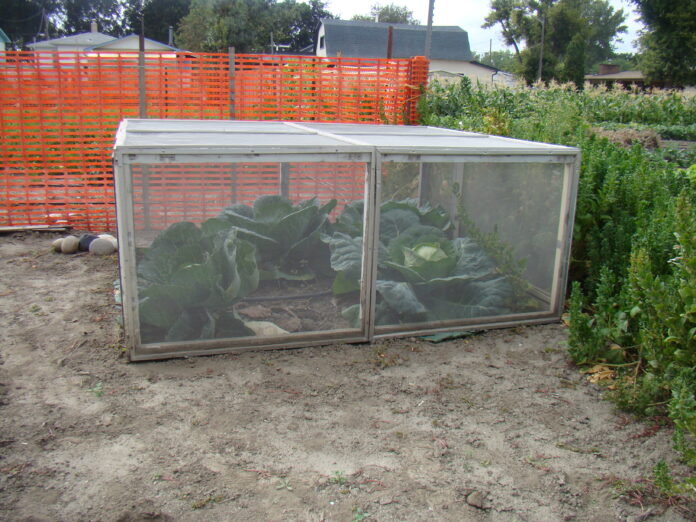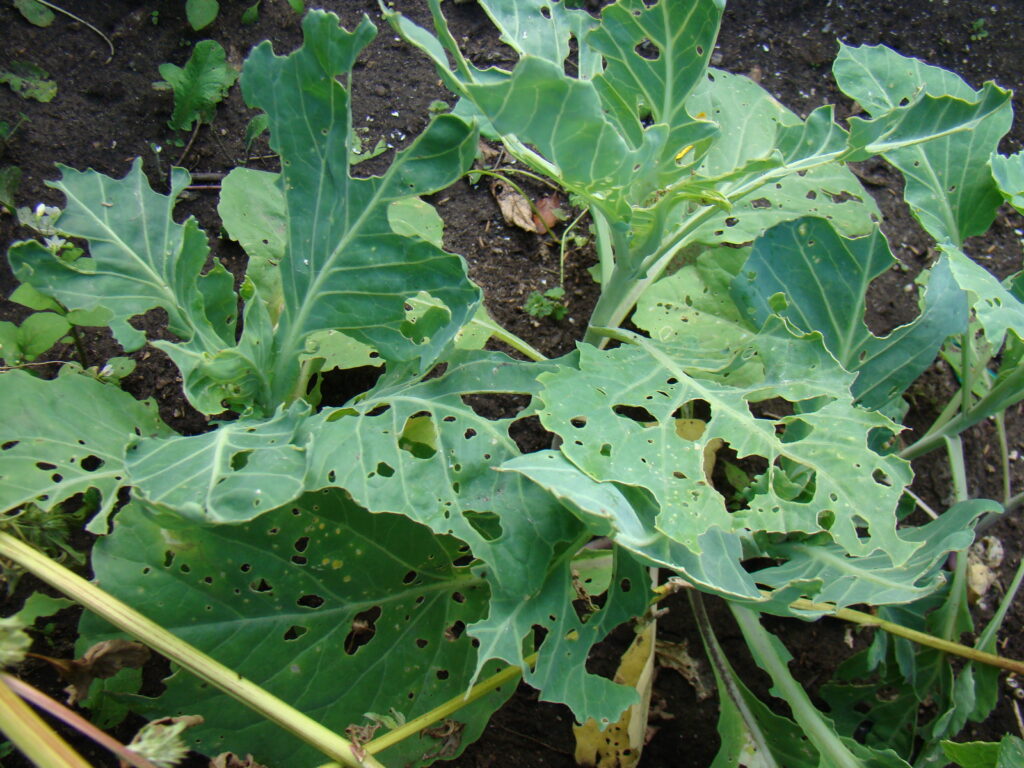
-by Jackie Bantle
Saskatchewan Perennial Society
Along with the success of growing a vegetable garden often comes the challenge of managing pests. There never seems to be a shortage of insects in the garden: some are good, some are not so good. Following are a few of the common insect pests in your garden that can cause damage.
Cabbage loopers are the fleshy, green caterpillars that can be found inside broccoli, cabbage and cauliflower heads throughout the season. Not only do they chew holes in the leaves of the plant but their green mushy excrement can be found throughout the crevices of leaves and heads. Although the excrement is not harmful to humans, it is unsightly. The adult form of the cabbage looper is the small white butterfly often found flying around the garden. These butterflies lay their yellow colored eggs on the underside of leaves which then hatch into the caterpillars. Covering plants with thin supported crop covers or fine screens will prevent butterflies from laying their eggs on plants. Bacillus thuringiensis (Bt) is a type of bacteria that is not harmful to humans and can be sprayed on the plant to control loopers. Check with your local garden centre for available products.
Root maggots are a huge problem in brassica vegetables in areas with large acreages of canola. Pupae overwinter in the soil. Grey-black flies emerge from the soil and lay eggs at the base of cole crops. The first round of egg-laying occurs from late May to early June. Shortly after eggs are laid, white maggots hatch and attack the roots of the young plants. Brassica plants affected by root maggots will appear stunted and older leaves will turn yellow or purplish-red and then eventually die. Affected plants can easily be pulled out of the ground since the roots have been eaten off my maggots. In severe cases, the maggots will be visible. A second flush of flies and maggots occurs in mid-late August. At this later stage, maggot damage may also occur at the base of the cabbage heads: they eat holes into the head. There are no chemical controls for root maggots. Covering brassica crops with a thin crop cover can help but it does not eliminate maggots that develop from overwintering pupae. Radishes have become especially difficult to grow due to maggot problems. Try growing radishes and other brassica crops in containers or raised beds filled with new growing media each year.

Has something been eating your potato leaves? Colorado potato beetle adults are about 1cm long, orangish-red to yellow in color with black stripes on their back. Overwintering adults appear in the late May or early June; feed for a few days on the emerging potato crop and then mate. Individual females lay 300-500 eggs from June to late July. These eggs will be found in yellow clusters on the underside of potato leaves. Once the eggs hatch, larvae appear as 3-5mm long yellow-orangey red soft bodied organisms. The larvae feed heavily on the leaves for the next 3-5 weeks and then burrow into the soil. Pupation occurs in the soil and new adults emerge in 1-2 weeks. The new adults feed for a few days and then begin to look for a protected spot to hibernate through the coming winter. Whenever possible, avoid growing potato plants in or near the same area of the garden for a minimum of three years. Consider hiring your children to pick the first flush of adult beetles by hand: this will reduce eggs laid, larvae and the number of adult beetles later in the season. Rototill in fall to expose the overwintering adult beetle to cold and dehydration. For chemical controls contact your local garden center.
With the increasing acreage of field corn being grown on the Prairies, there is also an increase in the number of corn pests in Prairie gardens. There’s nothing more disappointing that husking that beautiful cob of corn out of your garden and finding a disgusting worm near the tip of the ear. Although the corn earworm often damages only a few kernels at the end of the cob, their presence and droppings can quickly destroy anyone’s appetite. If corn earworms are a problem in your garden, try applying mineral oil to the silk of each ear of corn, as soon as the silk is present, to prevent invasion by the worm.
Remember that for every pest, there is a beneficial insect out there that likes to eat your pest. In nature, there is always a balance. Trying to maintain that natural balance is the key to having healthy vegetables, a healthy yard and a healthy ecosystem.
This column is provided courtesy of the Saskatchewan Perennial Society (SPS; saskperennial@hotmail.com ). Check our website saskperennial.ca) or Facebook page (facebook.com/saskperennial). All Saskatchewan Perennial Society events are on hold until further notice.

